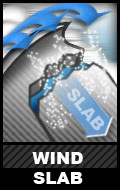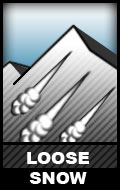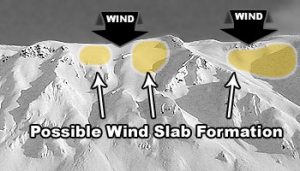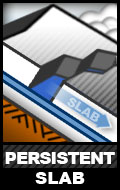Avalanche Danger Forecast
Issued Thursday, February 4, 2021 at noon for the greater Anchorage area Western Chugach Mountains (i.e. Chugach State Park). View map of primary forecast area here.
Avalanche danger will remain at moderate through this forecast period.
Please know that a danger rating of “moderate” in no way implies “safe” avalanche conditions and that 34% of avalanche fatalities occur when the danger rating is moderate. Tragically, three died in a Chugach State Park avalanche-related accident Tuesday, February 2, 2021 when the danger rating was moderate (more in “Discussion” section below).
Small, fresh wind slabs on leeward terrain in the upper elevations will be the primary avalanche problem. These are generally not expected to be large enough to bury a person (in the absence of terrain traps), but could cause a fall or loss of control with associated dangers (as is suspected to have occurred in the recent fatal accident).
Small to medium sized persistent slabs are a threefold lower probability but higher consequence avalanche concern.
First, and most likely to be human triggered, moderate easterly to southerly wind accompanied the few inches of snowfall Tuesday night into Wednesday and created wind slabs that were EXTREMELY sensitive/touchy/reactive to human triggers on steep upper elevation leeward terrain (primarily northerly aspects) Wednesday afternoon. As these wind slabs developed on top of an old snow surface that was EXTREMELY faceted by recent very cold temperatures, and continued cold temperatures this forecast period will further weaken the snowpack, they may continue to be reactive to human triggers.
Second, moderate to strong northerly winds in exposed upper elevation areas (primarily on the western side of Chugach State Park close to Knik Arm) as recently as Monday created wind slabs that may also still be reactive to human triggers. These developed on very faceted near surface snow or wind-packed and slick snow and continued cold temperatures this forecast period (that will further weaken the snowpack) are not expected to facilitate their bonding and stabilization.
Third, and while not likely, diverse and widespread persistent weak layers deeper in the snowpack may still be reactive to human triggers if one is unlucky enough to find a “sweet spot” trigger point similar to that found by a party in the South Fork Eagle River area on Tuesday, January 26 (more details here). These largest and most dangerous persistent slabs are most likely to be found in the typically drier areas of Chugach State Park that have a generally thinner and weaker snowpack (from South Fork Eagle River north to Knik River, and especially on the west side of the range closer to Knik Arm).
Mountain Weather:
Friday: increasing clouds with a chance of light snow later, light to moderate easterly to southerly wind, alpine temps in the teens to low 20s
Saturday: decreasing clouds, light to moderate northerly wind (possibly strong in exposed upper elevation areas especially on the west side of the range near Knik Arm), alpine temps in the teens
Sunday: clearer early with increasing clouds and a chance of light snow later, light to moderate wind, alpine temps in the single digits to low teens
Discussion:
Our deep condolences go out to the loved ones of the three victims of a fatal accident that occurred Tuesday, February 2, 2021 in Chugach State Park. There hasn’t been an avalanche related fatality involving a human in the park since 2011 (info here), although at least one canine companion has died in a human triggered avalanche since then (info here and here).
While details are still unclear at this time, it’s suspected that three climbers died from trauma due to a small avalanche that swept them down one of the northerly couloirs above Mirror or Edmonds Lake on Bear Mountain in the Peters Creek area (see map here).
This highlights, as mentioned above, that “moderate” avalanche danger in no way means avalanche conditions are “safe” or “not that bad.” The persistent slab avalanche problems characteristic of the Chugach State Park snowpack are notorious for their unpredictability. Furthermore, if on steep and/or exposed terrain or if involving a terrain trap, even a very small avalanche at low danger could result in casualty.
As pointed out in our observations from February 1, strong north winds affected the Knik Arm area (which includes the area of the recent avalanche accident) Sunday-Monday. As mentioned in our forecast for February 1-4, a variety of avalanche problems existed that could prove deadly on terrain similar to that of the Bear Mountain accident.
While we will be helping instruct a backcountry skiing and avalanche safety class for UAA this weekend, and will be unavailable, we will provide an update next week when more information on the accident is available.
In addition to the existing avalanche problems pointed out in the observations and forecast linked to above, we found newly developed wind slabs from the few inches of new snow Tuesday night into Wednesday to be extremely reactive to human triggers Wednesday afternoon:
View this post on Instagram
Avalanche Problems:
 Human triggered wind slabs up to D2 in size are possible above 2500′ on leeward terrain steeper than 35º.
Human triggered wind slabs up to D2 in size are possible above 2500′ on leeward terrain steeper than 35º.
There’s a chance for another round of light snowfall Friday night into Saturday and there’s already a few to several inches of existing loose snow available for transport into fresh wind slabs this weekend.
It’s likely that any new snow will be accompanied by moderate wind capable of building fresh wind slabs on leeward terrain in the upper elevations, and areas with moderate wind will likely experience some wind loading this weekend regardless of any new snow.
Any new wind slabs this weekend are not expected to bond quickly as they will form on weak and un-cohesive snow from Tuesday-Wednesday, heavily faceted snow from the January 23-24 storm, or older very firm and slick “slide-for-life” wind-packed snow. All of the possible surfaces any new wind slabs may form on this weekend are expected to make wind slabs reactive to human triggers on steep terrain.
As winds will shift through this forecast period, and considering that the terrain of the forecast area channels winds in varying directions, it will be important to pay close attention to wind scouring and loading patterns in the upper elevations in order to better understand where potentially reactive wind slabs may exist.
Wind slabs are most likely to exist below corniced areas and along the lee sides of ridges and cross-loaded features like gullies:
Active wind loading, recent avalanches, and shooting cracks are red flag indicators of wind slab danger. However, red flags like recent avalanches and shooting cracks may not be present this forecast period.
Relatively densely-packed (firm and “punchier” feeling) snow and pockets of deeper snow (especially with a bulbous or fat appearance) are expected to be the most reliable indicators of wind slabs this forecast period. If you look closely at the snow surface, you may be able to distinguish where wind slabs exist due to the snow having a more textured, densely-packed, consolidated, and/or cohesive appearance.
Pole probing and hand pits are a quick and effective means of assessing this problem as you travel. Use pole probing to quickly feel out areas of denser, wind-packed snow overlying looser and weaker snow. Use hand pits to quickly assess how near-surface layers of snow are bonded.
Digging a snowpit and conducting a compression test and/or extended column test will provide an even better assessment of bonding and instability before you travel on terrain of consequence.
You can also assess wind slab instability via safer “test slopes” that are representative of higher consequence terrain.
Human triggered persistent slabs up to D2.5 in size are possible on all aspects above 2500′ where the terrain is steeper than 35º.
This is a lower probability but higher consequence avalanche problem than the wind slab problem. These persistent slabs are unpredictable. Review the discussion from past forecasts (here and here) for an example of their unpredictability.
Such hard slabs (these avalanches are likely to break deeper down in the snowpack where layers are much denser than near the surface) have a tendency to release above and around a human trigger, rather than at the trigger’s feet, which can make escape difficult. In addition, hard slab avalanche debris is more likely to cause trauma than debris from soft snow.
Diverse and widespread persistent weak layers exist in the snowpack. Faceted snow exists above and below crusts in some areas, sandwiched between wind packed layers in many areas, and a basal weak layer of advanced facets and depth hoar is widespread.
While they aren’t expected to be present this forecast period, always be on the lookout for red flag warnings of persistent slab danger: recent avalanches, collapsing (aka “whumphing“), and shooting cracks. Understanding this avalanche problem where you intend to travel will require in-depth analysis: digging snowpits, conducting instability tests, and analyzing snowpack stratigraphy (layering).
Terrain management is simply the best way to avoid tricky avalanche problems: don’t expose yourself to terrain capable of producing a large and dangerous persistent slab.
 Both natural and human triggered dry loose snow avalanches are possible above 3000′ on all aspects where the terrain is steeper than 38º.
Both natural and human triggered dry loose snow avalanches are possible above 3000′ on all aspects where the terrain is steeper than 38º.
In many areas the new snow from Tuesday-Wednesday has not been affected by the wind and remains light, dry, and very un-cohesive. While low density and low volume, it will sluff easily from steep terrain.
Any new snow Friday night into Saturday will further add to the likelihood and volume of human triggered sluffing on steep terrain.
While these relatively small avalanches (D1) aren’t much of a concern in regard to burial, they do have the potential to cause a fall or loss of control. While not likely, it’s possible that a loose snow avalanche could trigger a larger wind or persistent slab as it descends a slope and gains mass.
Don’t let a loose snow avalanche catch you off guard. Manage your sluff if descending steep terrain via ski or snowboard. If it happens to be windy and you’re climbing steep and/or exposed terrain, be mindful of the potential for heavy spindrift that could knock you off your feet and take you for a ride.
Before traveling on or under terrain that has the potential to avalanche think about the consequences, and have a plan (to escape the avalanche, for re-grouping, and rescue).
Always be mindful of terrain traps that can make even a small avalanche deadly.
Click the hyperlinks and icons to learn more.




